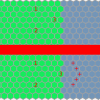Ok, to illustrate, see 2 map setups for the coast:
If sea tiles are equal to land ones or at least not much worse, the second setup is always better, because you just have more land (marked with "+"). It's no-brainer choice to settle on coast. If sea tiles are significantly worse than land ones, it's quite complex strategic choice as in first setup the third city could potentially get more land (from the first 2 cities), while in second setup your overall workable land is bigger.
That's what I'm talking about.


